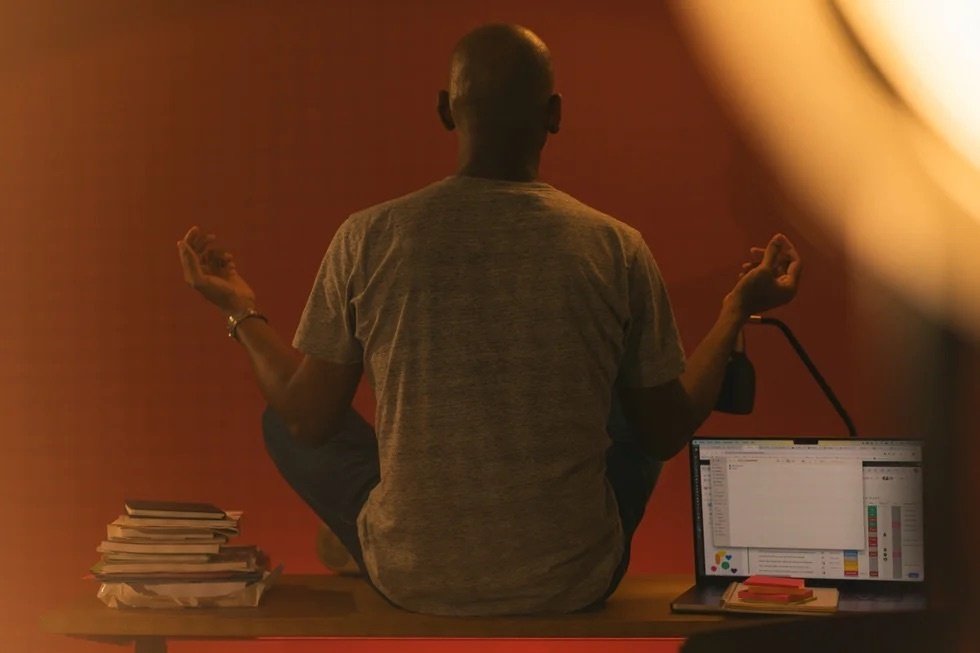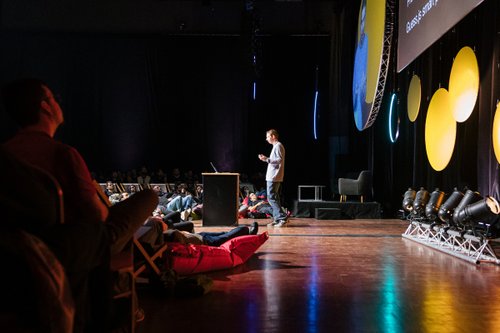7 signs you need a coffee break: Recognizing workplace fatigue
Jun 13, 2024
6 mins


US Editor at Welcome to the Jungle
Have you ever found yourself in the middle of a workday, eyes locked on a screen, scanning the same few lines of text but absorbing none of it? This very moment might be the universe’s not-so-subtle hint that it’s time for a pause—a coffee break, perhaps. In our relentless pursuit of efficiency, where the drive to keep pushing forward is ever-present, acknowledging the importance of taking a pause is essential, yet frequently ignored.
So, how do you know when to step back? From the all-too-familiar screen glaze to the mysterious yawn chains echoing through the office, the signs are there if we pay attention. With 20+ years of HR experience, wellness enthusiast Nesa Johnson is eager to dive into the world of workplace fatigue to uncover the seven signs that scream for a coffee—or tea—break.
1. Screen glaze: Re-reading over and over and over…
Have you ever caught yourself reading the same passage over and over without understanding it? This moment, where text blurs into meaninglessness, is a clear sign that a break is overdue. Johnson shares her experience: “I’m thinking, ‘Wait, didn’t I just read this?’ Like when watching a movie and I find myself having to rewind a scene because my attention has wandered off in a different direction.”
Taking short, intentional breaks is key to counteract screen glaze and eye strain. Step away from your screen, engage in another activity, or close your eyes and deep breathe for a few minutes. This pause refreshes your mind, enhancing focus when you return to work. Also, changing your environment or task can keep you engaged and prevent distraction.
2. Pause, breathe, unfreeze: The screen apnea phenomenon
We’re familiar with sleep apnea, a condition interrupting breathing during sleep, but screen apnea might be new to some. This term describes the tendency to hold one’s breath or breathe shallowly while using devices like smartphones, computers, and tablets. Emerging from our digital habits and often without our awareness, screen apnea happens when we’re deeply engrossed in screens, leading to irregular breathing patterns. This phenomenon can heighten stress and diminish focus due to altered blood oxygen and carbon dioxide levels.
Workers need mindfulness in their digital interactions, explains Johnson. “I started to notice it when I read emails. I was holding my breath and breathing shallowly… This is where mindfulness comes in: Am I breathing properly now, and what are my current feelings and bodily sensations?” Her recommendation? James Nestor’s breathing techniques include mindful breathing, nasal breathing instead of mouth breathing, slow and deep breathing exercises, and incorporating specific breathing patterns like the “4-7-8” technique to improve relaxation and sleep.
3. Yawn chain reaction: Nature’s reminder to rest
Caught in the yawn chain reaction? One yawn in the office, and suddenly, it’s like a domino effect of wide-open mouths. It’s more than just catching some z’s contagiously; it’s our collective body’s way of saying, “Hey, let’s take a breather.”
Johnson connects the dots between the yawn chain and our deeper, physical states of rest: “If you’re always on the go and physically tired, you might find it hard to sleep at night, maybe you’re waking up throughout the night, or you’re still tired despite going to bed on time.” Yawn chain be damned; skimping on downtime can lead to restless nights and groggy mornings. So, let’s not wait for the next yawn to remind us – a little rest goes a long way in keeping workplace fatigue at bay!
4. Concentration collapse: Losing focus on the small stuff
Ever find yourself zoning out or taking forever to make a simple choice, especially when it really shouldn’t be that big of a deal? Johnson gets it, pointing out that struggling to keep your mind on track or dawdling over decisions on the small stuff might just be your brain waving the white flag of fatigue.
Taking regular, short breaks can help combat this concentration collapse. Step away from your work, maybe take a walk, or switch to a different task for a few minutes. This shift can help clear the mental fog, making it easier to focus and decide when to return.
5. Digital drift: When your brain craves a detox
Ever caught yourself deep in the web, flipping through tabs of cat videos when you were supposed to be crunching numbers or writing an email? It’s a classic sign your brain is hunting for a timeout. This digital meandering is more than procrastination; it’s an SOS from your mind, craving a change of digital scenery or perhaps a break from screens altogether.
Try setting intentional breaks for a digital detox to steer back on course. Even a five-minute shift away from the screen—stretching, sipping tea, or just gazing out the window—can reel your focus back in.
6. The irritability index: Always peeved with your colleagues
A short fuse with colleagues or work situations reflects emotional fatigue and the need for a mental health break. The irritability index might seem like just another day of being peeved at colleagues or the endless loop of office drama. However, Johnson digs deeper, highlighting how these flare-ups are more than just bad moods—they’re playing with the psychological complexities of workplace politics.
According to Johnson, the crux lies in communication: “We’re spending most of our day… in ways that we have to interpret that we’re already prone to interpret negatively.” This tension, miscommunication, and constant decoding of messages fuel irritability.
Focus on clear and compassionate communication to mitigate these effects. Johnson advises taking a step back to assess our reactions and interpretations, encouraging us to approach interactions with empathy and understanding. Cultivating a culture of open dialogue can help dispel misunderstandings and reduce stress. Additionally, incorporating regular mental health breaks and mindfulness practices into our routines can support emotional resilience.
7. The apathy abyss: Beyond a case of the Mondays
Welcome to the apathy abyss, where tasks that once sparked joy now barely raise an eyebrow. This isn’t just a case of the Mondays; it’s the sign of a deeper dive into burnout territory, where the zest for work fizzles out, leaving a trail of “meh” in its wake.
“When thinking of the psychological effects of workplace fatigue, I think about stress and burnout,” says Johnson. Identifying the early warning signs of this descent can empower individuals to seek necessary changes through lifestyle adjustments or professional support. Ignoring these symptoms, however, may risk a complete detachment not only from work but also from personal passions, deepening the abyss of apathy.
Identifying energy-draining tasks
To combat workplace fatigue, you need to identify which tasks drain your energy or energize you. Johnson suggests conducting a “meeting audit” daily, weekly, or monthly to evaluate the energy levels associated with different tasks. Grading activities on a scale from one (low energy) to five (high energy) can help you identify patterns in what energizes and drains you.
For instance, you might find solitary work fulfilling and creative, while collaborative efforts feel more exhausting. Recognizing and accepting these trends, a form of mindfulness can help you understand your reactions to energy-draining situations and find ways to navigate them while honoring your needs.
How to recharge
Johnson acknowledges the emotional impact of draining interactions, but she advocates for owning your feelings and being honest about them with yourself and others. As for recharging the post-energy drain, Johnsons says you must find what genuinely rejuvenates you. For her, music plays a significant role in setting the tone for her day and helping her recover from challenging moments. “Just find an activity that energizes you.”
Practicing mindfulness in the workplace
Mindfulness is a conscious effort to be aware of our thoughts, emotions, bodily sensations, and surrounding environment in real time. In the workplace, it encourages employees to be fully present in tasks, meetings, and interactions, focusing actively and avoiding distractions. It emphasizes accepting thoughts, feelings, and situations without judgment, not as a resignation but as acknowledging reality to enhance problem-solving and decision-making. Moreover, it cultivates a culture of reflection, teaching employees to pause before reacting.
As Johnson puts it, “I turn to meditation to address feelings of discomfort or unsafety, seeking to return to a sense of ‘home’ within myself.” Noticing your breath is a foundational aspect of mindfulness so becoming aware of your breathing as you work is a great place to start.
“For anyone new to this, I recommend a small sign or post-it note near your monitor that reads ‘Remember to breathe!’ or something similar for a moment-to-moment reminder,” she notes. She also suggests finding a guided meditation that suits you. “There’s a wealth of free resources available, particularly on YouTube. My preferred meditation app is Insight Timer, which offers a wide range of options, including meditations related to different religions. You’ll likely encounter a guide whose voice truly resonates with you. I have my favorites.”
Redefining self-care
While sleep is central in tackling workplace fatigue, Johnson stresses the broader scope of self-care beyond typical indulgences. “[Self-care has] become a somewhat common and perhaps overused term nowadays, but for me, self-care isn’t necessarily about massages or meditation. Rather, it involves considering what my future self will benefit from.” A significant aspect for me is choosing what to wear in the morning. So, by choosing my outfit the night before, I’m helping future Nesa, who will be grateful tomorrow for the foresight.”
Balancing hard work with self-care is essential for maintaining productivity and health in the workplace. Signs such as screen glaze and yawn chains remind us to prioritize our well-being and acknowledge the need for deliberate breaks. Adopting mindfulness practices like mindful breathing and daily preparation can help combat workplace fatigue, allowing us to find internal solutions to external stresses and enhance our overall effectiveness.
Photo: Welcome to the Jungle
Follow Welcome to the Jungle on Facebook, LinkedIn, and Instagram and subscribe to our newsletter to get our latest articles every week!

More inspiration: Navigate daily work

From the boardroom to the bedroom: Corporate phrases we use at home
Have you ever noticed yourself using "work speak" in your personal life? If so, you're not alone ...
May 22, 2024

Is it worth joining a shadow board?
Are shadow boards a reverse mentoring system that benefits all, or just labor exploitation in a new suit?
Dec 15, 2022

Here’s why you don’t need to be irreplaceable at work
Do we want to be considered irreplaceable at work? Sure, it might give us a confidence boost in the moment, but is it worth it in the long run?
Sep 07, 2022

Thinking of recommending a friend for that job? Here’s how to get it right
You know them as a friend, but what are they really like at work? And how liable are you if things go wrong?
Nov 23, 2021

Public speaking: 7 tips from a pro
Your legs are shaky, your heart is racing and your voice is weak. Many of us are all too familiar with the signs of anxiousness...
Nov 15, 2021
The newsletter that does the job
Want to keep up with the latest articles? Twice a week you can receive stories, jobs, and tips in your inbox.

Looking for your next job?
Over 200,000 people have found a job with Welcome to the Jungle.
Explore jobs